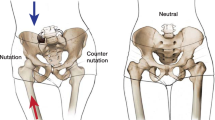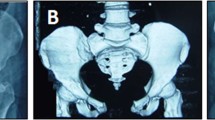Abstract
Purpose
Sacroiliac screw fixation is the method of choice for the definitive treatment of unstable posterior pelvic-ring injuries; however, this technique is demanding and associated with a high risk of iatrogenic neurovascular damage. This study evaluates whether minimally invasive transiliac locked compression plate stabilisation may be an alternative to sacroiliac screw fixation in unstable posterior pelvic-ring injuries.
Methods
We performed a retrospective analysis of patients with unstable pelvic-ring injuries treated with a transiliac locked compression plate at a level I trauma centre. Outcome evaluation was assessed using the Pelvic Outcome Score and analysis of complications, intraoperative fluoroscopic time, and duration of the surgical procedure.
Results
Twenty-one patients were available for follow-up after an average of 30 months. The main findings were as follows: Overall outcome for the Pelvic Outcome Score was excellent in 47.6% (ten patients), good in 19% (four patients), fair in 28.6% (six patients), and poor in 4.8% (one patient). Average operation time was 101 min and intraoperative fluoroscopic time averaged 74.2 s. No iatrogenic neurovascular injuries were observed.
Conclusion
Minimally invasive transiliac locked compression plate stabilisation may be a good alternative to sacral screw fixation because it is quick, safe and associated with a good functional outcome.

Similar content being viewed by others
References
Albert MJ, Miller ME, MacNaughton M et al (1993) Posterior pelvic fixation using a transiliac 4.5-mm reconstruction plate: a clinical and biomechanical study. J Orthop Trauma 7:226–232
Atlihan D, Bozkurt M, Turanli S et al (2004) Anatomy of the posterior iliac crest as a reference to sacral bar insertion. Clin Orthop Relat Res 141:145
Beaule PE, Antoniades J, Matta JM (2006) Trans-sacral fixation for failed posterior fixation of the pelvic ring. Arch Orthop Trauma Surg 126:49–52
Carlson DA, Scheid DK, Maar DC et al (2000) Safe placement of S1 and S2 iliosacral screws: the "vestibule" concept. J Orthop Trauma 14:264–269
Cole JD, Blum DA, Ansel LJ (1996) Outcome after fixation of unstable posterior pelvic ring injuries. Clin Orthop Relat Res 160:179
Comstock CP, van der Meulen MC, Goodman SB (1996) Biomechanical comparison of posterior internal fixation techniques for unstable pelvic fractures. J Orthop Trauma 10:517–522
Giannoudis PV, Tzioupis CC, Pape HC et al (2007) Percutaneous fixation of the pelvic ring: an update. J Bone Joint Surg Br 89:145–154
Griffin DR, Starr AJ, Reinert CM et al (2003) Vertically unstable pelvic fractures fixed with percutaneous iliosacral screws: does posterior injury pattern predict fixation failure? J Orthop Trauma 17:399–405
Grossterlinden L, Rueger J, Catala-Lehnen P et al (2010) Factors influencing the accuracy of iliosacral screw placement in trauma patients. Int Orthop [Epub ahead of print] (doi:10.1007/s00264-010-1092-7)
Keating JF, Werier J, Blachut P et al (1999) Early fixation of the vertically unstable pelvis: the role of iliosacral screw fixation of the posterior lesion. J Orthop Trauma 13:107–113
Konrad G, Zwingmann J, Kotter E et al (2010) Variability of the screw position after 3D-navigated sacroiliac screw fixation. Influence of the surgeon's experience with the navigation technique. Unfallchirurg 113:29–35
Krap**er D, Larndorfer R, Struve P et al (2007) Minimally invasive transiliac plate osteosynthesis for type C injuries of the pelvic ring: a clinical and radiological follow-up. J Orthop Trauma 21:595–602
Lindahl J, Hirvensalo E (2005) Outcome of operatively treated type-C injuries of the pelvic ring. Acta Orthop 76:667–678
Moed BR, Fissel BA, Jasey G (2007) Percutaneous transiliac pelvic fracture fixation: cadaver feasibility study and preliminary clinical results. J Trauma 62:357–364
Moed BR, Geer BL (2006) S2 iliosacral screw fixation for disruptions of the posterior pelvic ring: a report of 49 cases. J Orthop Trauma 20:378–383
Mullis BH, Sagi HC (2008) Minimum 1-year follow-up for patients with vertical shear sacroiliac joint dislocations treated with iliosacral screws: does joint ankylosis or anatomic reduction contribute to functional outcome? J Orthop Trauma 22:293–298
Nork SE, Jones CB, Harding SP et al (2001) Percutaneous stabilization of U-shaped sacral fractures using iliosacral screws: technique and early results. J Orthop Trauma 15:238–246
Oliver CW, Twaddle B, Agel J et al (1996) Outcome after pelvic ring fractures: evaluation using the medical outcomes short form SF-36. Injury 27:635–641
Pohlemann T, Gansslen A, Schellwald O et al (1996) Outcome after pelvic ring injuries. Injury 27(Suppl 2):B31–B38
Pohlemann T, Gansslen A, Tscherne H (2000) Fracture of the sacrum. Unfallchirurg 103:769–786
Reilly MC, Bono CM, Litkouhi B et al (2003) The effect of sacral fracture malreduction on the safe placement of iliosacral screws. J Orthop Trauma 17:88–94
Routt ML Jr, Simonian PT, Mills WJ (1997) Iliosacral screw fixation: early complications of the percutaneous technique. J Orthop Trauma 11:584–589
Templeman D, Schmidt A, Freese J et al (1996) Proximity of iliosacral screws to neurovascular structures after internal fixation. Clin Orthop Relat Res 194:198
Tornetta P III, Matta JM (1996) Outcome of operatively treated unstable posterior pelvic ring disruptions. Clin Orthop Relat Res 186:193
van den Bosch EW, Van der KR, Hogervorst M et al (1999) Functional outcome of internal fixation for pelvic ring fractures. J Trauma 47:365–371
van den Bosch EW, van Zwienen CM, van Vugt AB (2002) Fluoroscopic positioning of sacroiliac screws in 88 patients. J Trauma 53:44–48
van Zwienen CM, van den Bosch EW, Snijders CJ et al (2004) Biomechanical comparison of sacroiliac screw techniques for unstable pelvic ring fractures. J Orthop Trauma 18:589–595
Vanderschot P, Meuleman C, Lefevre A et al (2001) Trans iliac-sacral-iliac bar stabilisation to treat bilateral lesions of the sacro-iliac joint or sacrum: anatomical considerations and clinical experience. Injury 32:587–592
Yinger K, Scalise J, Olson SA et al (2003) Biomechanical comparison of posterior pelvic ring fixation. J Orthop Trauma 17:481–487
Yucel N, Lefering R, Tjardes T et al (2004) Is implant removal after percutaneous iliosacral screw fixation of unstable posterior pelvic ring disruptions indicated? Unfallchirurg 107:468–474
Zwingmann J, Konrad G, Mehlhorn AT et al (2010) Percutaneous iliosacral screw insertion: malpositioning and revision rate of screws with regards to application technique (navigated vs. Conventional). J Trauma 69:1501–1506
Authors contributions
TH performed all operations, IH and PK collected and analysed data, HR, TH, RS and PK prepared the manuscript.
Author information
Authors and Affiliations
Corresponding author
Rights and permissions
About this article
Cite this article
Kobbe, P., Hockertz, I., Sellei, R.M. et al. Minimally invasive stabilisation of posterior pelvic-ring instabilities with a transiliac locked compression plate. International Orthopaedics (SICOT) 36, 159–164 (2012). https://doi.org/10.1007/s00264-011-1279-6
Received:
Accepted:
Published:
Issue Date:
DOI: https://doi.org/10.1007/s00264-011-1279-6




